

Warm Tip: If you want to know more details about equipment, solutions, etc, please click the button below for free consultation, or leave your requirements!
In this post, we are going to talk about some parameters of hydrocyclone.
When we choose hydrocyclone, 8 parameters should be cosideried:
Diameter and height of the cylinder
Diameter of the feeding port
Diameter of the overflow pipe
Output size of the hydrocyclone
Insertion depth of the overflow pipe
Cone angle of the cylinder
Feeding pressure of the hydrocyclone
Slurry property
Let's dive right in!
Hydrocyclone is an effective separation equipment that carries on two-phase fluid separation by using the centrifugal force field, which is a non-motion separation device composed of the upper cylinder and the lower cone.
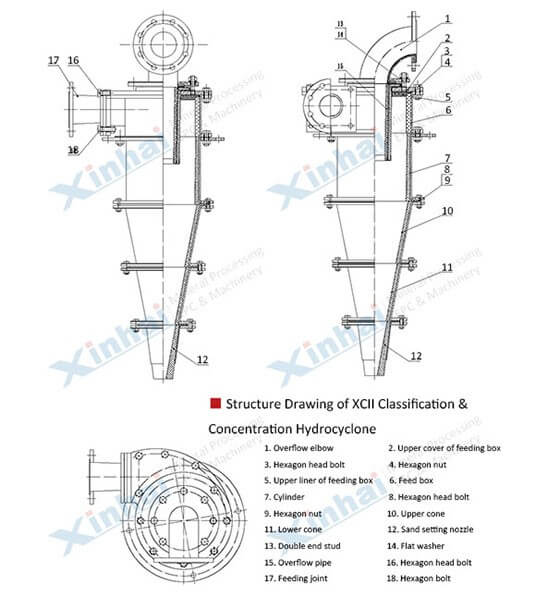
Different applications of hydrocyclone mean the various requirements for the technical parameters, including structure parameters, operating parameters, feeding properties. All of them are correlated and constrained mutually, each of them is not easy to be adjusted and controlled, so we must understand each technical parameter before choosing the hydrocyclone.
The diameter of the cylinder is the main reference point to determine the size of hydrocyclone, which has a certain ratio with other spare parts. Increasing the diameter of the cylinder can improve the processing capacity of the hydrocyclone, but the overflow particle size will be coarser at the same time. For the fine materials with large processing capacity, the cyclone unit composed of several small hydrocyclones in parallel can be adopted.
The height of the cylinder has a significant influence on the residence time of slurry and classification efficiency in the hydrocyclone. When the overflow pipe inserts into a certain depth, increasing the height of the cylinder can prolong the separation time, decrease the separation granularity and improve the separation efficiency, but also has the negative effect on reducing the output and increasing the energy consumption. In general, the effect is the best when the height of the cylinder is 0.6-1.0 times of the diameter of the cylinder.
Generally, the diameter of the feeding port is 0.13-0.25 times of the diameter of hydrocyclone. Appropriately increasing the diameter of the feeding port can improve the processing capacity of the hydrocyclone, but the classification efficiency will be reduced to some extent at the same time. In general, the cross-section shapes of the feeding pipes are mostly circular and rectangular, and most of them are rectangular. The configuration mode is that the long side is parallel to the axis of hydrocyclone, while the short side is perpendicular to the axis of hydrocyclone.
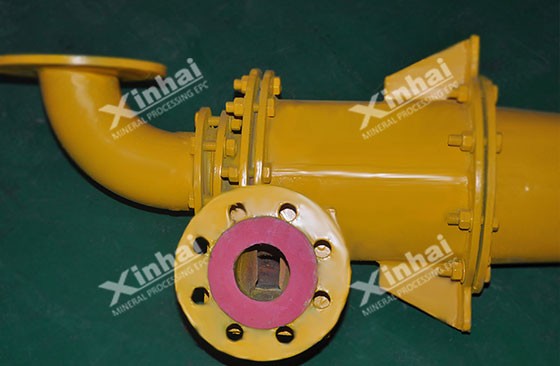
In the early stage, the structural form of feeding pipe and its connection with the cylinder body were mostly tangential,which was featured with simple structure and convenient configuration, but the flow pattern changed suddenly and the loss of on-way resistance was large,which was easy to generate turbulence. Later, involute feeding pipe was widely adopted, reducing the energy consumption, increasing production capacity and improving the separation efficiency.
The overflow pipes are mostly circular, and their diameters are usually 0.2-0.3 times of the diameter of the hydrocyclone. The main function of overflow pipe is to draw out the overflow product smoothly and constantly. Increasing the diameter of the overflow pipe, the overflow flow will be increased, but the overflow particle size will also be coarser, and the concentration will be increased while the fine particle decreases.
Usually, increasing the output diameter,the overflow is reduced, and the overflow is finer, the output capacity is increased, the concentration is lower, and the fineness is increased, but the processing capacity of hydrocyclone is not significantly affected. Reducing the output diameter, the discharging capacity of the sand setting is reduced. If too small, the coarse grains will stock at the top of the cone, so that appear jams phenomenon.
In general, the diameter of the output should ensure that the sand is discharged in an umbrella shape, and the included angle of 20°-30° is the ideal value. The diameter of output is usually 0.07-0.1 times of the diameter of the overflow pipe.
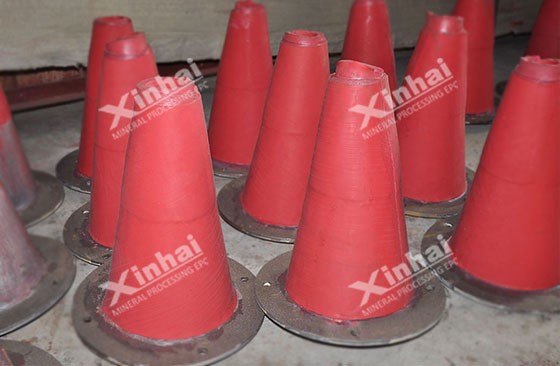
If the overflow pipe is inserted too shallow, the short-circuit flow rate will increase, the separation time will be shortened, and the content of coarse grain in the overflow product will increase, and the content of fine grain in the output product will increase,but the classification efficiency decreases. If the overflow pipe is inserted too deep, the coarse particle size at the bottom will enter the overflow, which reduces the classification efficiency of the hydrocyclone. In general, the insertion depth of the overflow pipe should be 0.5-0.8 times of the height of the cylinder.
Increasing the cone angle of the cylinder will decrease the height of hydrocyclone and increase the average radial velocity of the slurry. At the same time, because the flow resisting of the cone is increased, the upward flow velocity of the slurry will be increased corresponding, which leads to the overflow particle size become coarser.Therefore, it is suggested to adopt a large cone angle (30°-60°) to separate the coarse-grained particles, and adopt a small cone angle (15°-30°) to deal with mud removal.
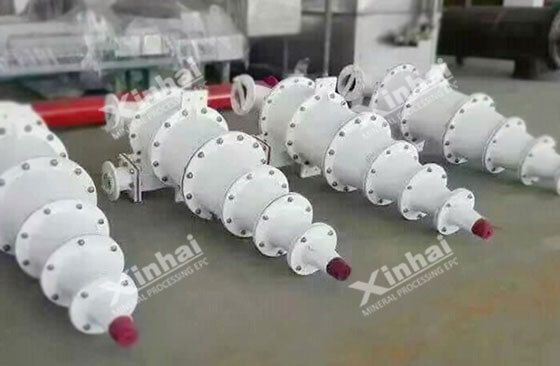
The feeding pressure has a direct influence on the processing capacity and separation particle size of the hydrocyclone. Normally, the feeding pressure should be maintained at 49-157 kPa. Increasing the feeding pressure can reduce the classifying granularity and increase the processing capacity. But at the same time, it can also significantly increase the power consumption and the wear of hydrocyclone. When the hydrocyclone works normally, the feed pressure should maintain a stable value.
The pulp properties mainly include density,particle size and pulp concentration. At the same slurry concentration, the higher the density of ore, the finer the grading granularity.
When the slurry concentration is large and the mud content is high, the viscosity and density of the pulp will increase accordingly, which increases the movement resistance of the particle size and makes the grading particle size coarser. The ideal slurry concentration should be determined by mineral processing test according to specific production condition.
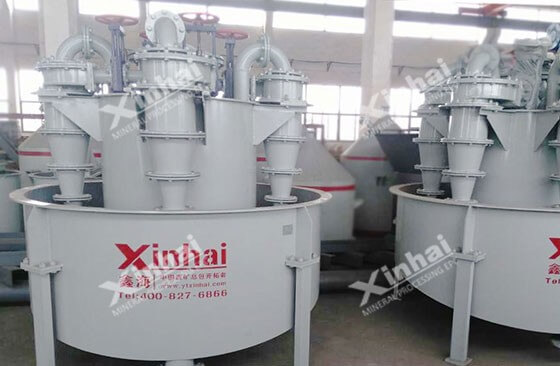
To sum up, the hydrocyclone operator can timely adjust the operation by adjusting the slurry pressure, changing the output diameter, slurry concentration, cone angle, the size of feed pipe and overflow pipe and the composition of particle size. In addition, it is recommended to purchase the hydrocyclone from the professional and regular hydrocyclone manufacturers and consult the professional hydrocyclone technicians according to the actual production conditions to achieve a win-win situation of technical indicators and economic benefits.
Last: 2 Key Factors That Affect the Magnetic Separation Method
15 Comparisons Teach You How to Choose Spiral Classifier or Hydrocyclone?
 7
7
 10462
10462
2How to Improve Your Hydrocyclone Efficiency?
 0
0
 3947
3947
3Development of Hydrocyclone
 2
2
 3832
3832


What Are the Differences Between CIP and CIL?
 11405
11405
 0
0